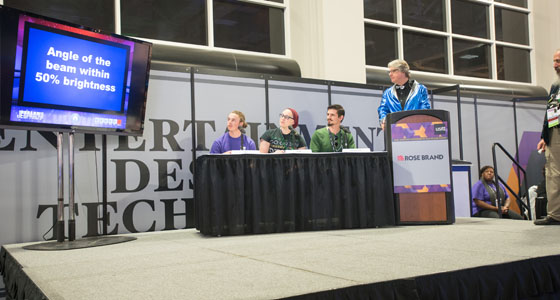Article provided by Dana Taylor, Technical Theatre Instructor
From the outset, conversations about eSET always included comments noting the potential usefulness of the program for high school students and their teachers. While geared toward recent college graduates and entry level technicians, much of what eSET covers is substantively addressed in many high school programs. Further, both the skills and knowledge covered in eSET readily fits into those schools offering technical theatre under the mantle of Career and Technical Education (CTE) and addresses their need for an end of course evaluative tool. After further discussions, it was determined that exploring the potential of an additional test was merited.
The newly created HS/CTE Working Group has been actively engaged in the identification of appropriate subject areas to be covered, gleaning questions from existing exams and creating a test which ensures continuity with the existing tests while creating a comprehensive introductory exam. This work is yielding a new test, BACKstage (Basic and Comprehensive Knowledge for High School Technical Theatre Students).
The BACKstage test will be built on the framework of the current Basics and Safety Test while adding questions drawn from the existing subject specific exams. It is the working group’s belief that a fairly broad range of knowledge should be addressed but with an understanding of appropriate depth for high school students. Further, the test should require a level of rigor beyond the typical “Drama 1” overview of the aspects of technical theatre. Areas covered include general safety, lighting and electrics, scenic construction, costuming and wardrobe, rigging, audio, projection, venue and jobs in the theatre. Although the test format has not been finalized, likely it will be akin to the existing format where each test is composed of randomized questions drawn from an existing question pool and will be taken online.
The eSET HS/CTE Working Group believes secondary school technical theatre education will benefit from eSET by ensuring that high school technicians are cognizant of appropriate procedures, skills and knowledge and consequently, will feel a connection to the greater theater community. This connection may encourage them to pursue technical theater in college and/or the private sector. By ensuring that students are exposed to industry level terminology and vocabulary, this test provides an opportunity to bridge secondary education to college and professional technical theater opportunities.
In as much as high school technical theatre education ranges from kids figuring it out themselves to formal classes taught by MFA holding, K-12 certified teachers, eSET provides a method for high school students to demonstrate what they know about theatre safety, terminology, careers, procedures, and practices. It also provides a tool for teachers to evaluate both student achievement and their local curriculum. The working group is also working on a curriculum guide and a topics list for the exam that can help guide teachers in curriculum decisions.
